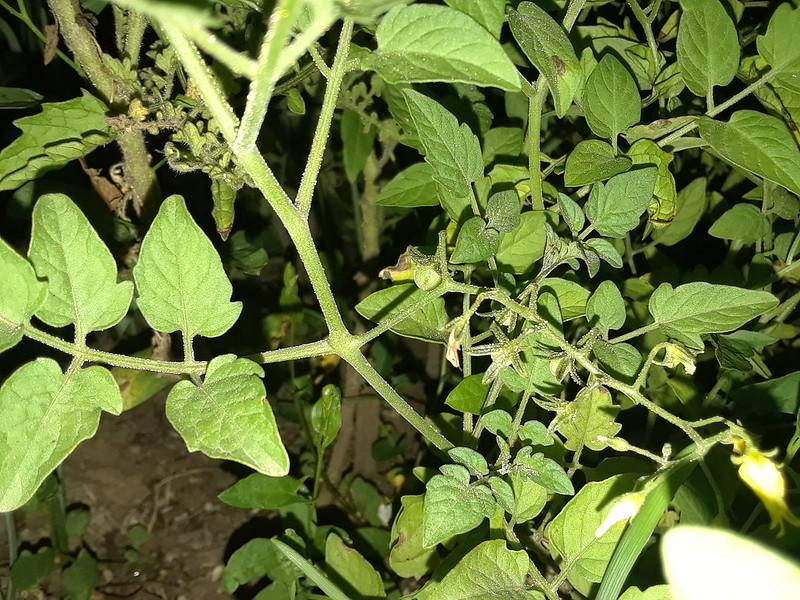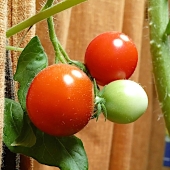


Rocket Mass Heater Plans: Annex 6" L-shaped Bench by Ernie and Erica
will be released to subscribers in:
soon!







 20180828_195032 by Andrew Barney, on Flickr
20180828_195032 by Andrew Barney, on Flickr



Andrew Barney wrote:Homegrown Goodness seems to be down.
Regardless, William, did i tell you i in fact had some volunteer tomatoes this year that self seeded from last year. They are flowering and fruiting now. Im interested to see what i get. It will be a surprise.
One of the cheesmaniae or pimpinellifolium that self seeded in the spot where the pimpinellifolium / peruvianum was growing last year looks like it May have a purple stripe on it! I wonder if it got bee crossed with peruvianum! Neither have stripes!
.. let me see if i can link the photo. . Be back soon!
EDIT:
20180828_195032 by Andrew Barney, on Flickr
Western Montana gardener and botanist in zone 6a according to 2012 zone update.
Gardening on lakebed sediments with 7 inch silty clay loam topsoil, 7 inch clay accumulation layer underneath, have added sand in places.




William Schlegel wrote:
Andrew Barney wrote:Homegrown Goodness seems to be down.
Regardless, William, did i tell you i in fact had some volunteer tomatoes this year that self seeded from last year. They are flowering and fruiting now. Im interested to see what i get. It will be a surprise.
One of the cheesmaniae or pimpinellifolium that self seeded in the spot where the pimpinellifolium / peruvianum was growing last year looks like it May have a purple stripe on it! I wonder if it got bee crossed with peruvianum! Neither have stripes!
.. let me see if i can link the photo. . Be back soon!
EDIT:
20180828_195032 by Andrew Barney, on Flickr
Interesting! Looks like a interspecies hybrid of some kind! How far away was the habrochaites also? When you say neither have stripes do you mean the two possible mothers you listed?








Western Montana gardener and botanist in zone 6a according to 2012 zone update.
Gardening on lakebed sediments with 7 inch silty clay loam topsoil, 7 inch clay accumulation layer underneath, have added sand in places.




I make a Maple Syrup instructional movie! Check it out HERE
SKIP books, get 'em while they're hot!!! Skills to Inherit Property
See me in a movie building a massive wood staircase:Low Tech Lab Movie








Mike Jay wrote:One of my sweet cherriettes looks like a yellow pear as well...
Western Montana gardener and botanist in zone 6a according to 2012 zone update.
Gardening on lakebed sediments with 7 inch silty clay loam topsoil, 7 inch clay accumulation layer underneath, have added sand in places.




Andrew Barney wrote:William, if you want the 10 seeds i got from TGRC for "Long John" mutant, you can have them. It's the same basic mutation as pear, but another one for extra long. Very weird. I think it would be interesting crossed to one of those "stuffing tomato" mutants.
Western Montana gardener and botanist in zone 6a according to 2012 zone update.
Gardening on lakebed sediments with 7 inch silty clay loam topsoil, 7 inch clay accumulation layer underneath, have added sand in places.
 2
2




Western Montana gardener and botanist in zone 6a according to 2012 zone update.
Gardening on lakebed sediments with 7 inch silty clay loam topsoil, 7 inch clay accumulation layer underneath, have added sand in places.





William Schlegel wrote:On the wild note a red partially eaten Penellii X domestic greeted me on my return home and I got about twenty seeds from it.




William Schlegel wrote:On the wild note a red partially eaten Penellii X domestic greeted me on my return home and I got about twenty seeds from it.




Andrew Barney wrote:
William Schlegel wrote:On the wild note a red partially eaten Penellii X domestic greeted me on my return home and I got about twenty seeds from it.
Yeah, that red one sounds interesting. How does it taste? Maybe you should save it or a cutting?
Western Montana gardener and botanist in zone 6a according to 2012 zone update.
Gardening on lakebed sediments with 7 inch silty clay loam topsoil, 7 inch clay accumulation layer underneath, have added sand in places.
 1
1




Western Montana gardener and botanist in zone 6a according to 2012 zone update.
Gardening on lakebed sediments with 7 inch silty clay loam topsoil, 7 inch clay accumulation layer underneath, have added sand in places.








Andrew Barney wrote:Im Not sure if I've put my thoughts into coherent words that I've shared all in one place, but i have a theory of sorts that not just S. Chilense can be used as a bridge species. I think others like pennellii might also work and other F1 or F2 hybrids as their genetics is already really crazy that they seem like they have greater potential to give or accept pollen from or to sources that wouldn't necessarily accept it. Even More so if you had some F1 species from one group crossing with F1 crosses of other species.
That Interesting plant in my garden that is most likely from natural direct seeded fruits from last year (mother is either pimpinellifolium or cheesmaniae) seems to be showing green striped fruits like habrochiates. It is possible it got crossed by bees with joseph's [F2/F3 fern x hab.]
I'm Not sure what you mean by the goldilocks zone haha, but if your referring to the (-5 days) method of pollinating inmature flowers to try and bypass any incompatibilities, you May need to use some oil to get the pollen to stick. Out of MANY hand pollinations this winter with that F2 pennellii, and some attempting cutting the stigma/style shorter for domestic pollen to reach the ovaries just in case, i had About 4 fruits develop. But i lost them when i planted it out.
Western Montana gardener and botanist in zone 6a according to 2012 zone update.
Gardening on lakebed sediments with 7 inch silty clay loam topsoil, 7 inch clay accumulation layer underneath, have added sand in places.
 1
1





Western Montana gardener and botanist in zone 6a according to 2012 zone update.
Gardening on lakebed sediments with 7 inch silty clay loam topsoil, 7 inch clay accumulation layer underneath, have added sand in places.




Western Montana gardener and botanist in zone 6a according to 2012 zone update.
Gardening on lakebed sediments with 7 inch silty clay loam topsoil, 7 inch clay accumulation layer underneath, have added sand in places.




Western Montana gardener and botanist in zone 6a according to 2012 zone update.
Gardening on lakebed sediments with 7 inch silty clay loam topsoil, 7 inch clay accumulation layer underneath, have added sand in places.




Western Montana gardener and botanist in zone 6a according to 2012 zone update.
Gardening on lakebed sediments with 7 inch silty clay loam topsoil, 7 inch clay accumulation layer underneath, have added sand in places.




William Schlegel wrote:
Mike Jay wrote:Hi William, the three batches of seeds I planted mostly all sprouted. Despite being planted over the course of three weeks they are all about the same size (1" high). We haven't had a frost in a month and we're past the "normal" last frost date.
Are these indeterminate varieties? I'm trying to figure out if I need to get some cages ready or not.
Hi Mike,
I checked our Purple Moosages and it looks like I sent you Anmore Dewdrop, Sweet Cherriette, and F3 Sungold or thereabouts. Did I throw in any other tomatoes? Anmore Dewdrop is semi determinate with petite plants. Sweet Cherriette is indeterminate but plants were small, and Sungolds are hmm- some of the F2's stopped producing in a very determinate sort of way. The way I grew tomatoes last year only my long season tomatoes really benefited from tomato cages. Nothing direct seeded much needed or got caged. Though some of the big direct seeded planting could have benefited from cages, but none of the three I mentioned above would much need a cage. When I had tons and tons of direct seeded plants last year I didn't cage much because honestly I don't own enough cages. Last year I caged what I could but also found that tomato cages are really useful for peas and favas. That said I should probably pop on a cage here and there just for show if nothing else. Might do it about the end of June when I have a little time off.
Mine are about 1 inch to three inches high with volunteers still popping up with each good rain event. My focus this year is on trying to grow lots of the Blue Ambrosia which I thought/think based on the observed nature of its exserted style should have a high outcrossing rate. So I literally just have a few or a clump of some of the most promising 2017 varieties for use as pollen donors and I started them inside.
Right now I am fighting weeds between schoolwork and getting ready for a work trip as soon as finals are over and my BCS rototiller won't start. Will get as much done as I can.
"People get out your way, when you're on fire". Richard Prior
 1
1




Brian Rodgers wrote:
Oh man I have a lot to learn. I'm trying, so here goes, "determinate?" From the Web: BOTANY
(of a flowering shoot) having the main axis ending in a flower bud and therefore no longer extending in length, as in a cyme.
If you wouldn't mind translating this for me?
I really need to learn about plants and this thread looks perfect, thank you William
Brian
Western Montana gardener and botanist in zone 6a according to 2012 zone update.
Gardening on lakebed sediments with 7 inch silty clay loam topsoil, 7 inch clay accumulation layer underneath, have added sand in places.









"People get out your way, when you're on fire". Richard Prior




Brian Rodgers wrote:Thank you so much for the clear explanation. That really helps. This sparked another question. Do tomato vines work well for chop and drop? Having a greenhouse full I get a lot of trimmings, which I put in the compost. Something seems different about the way tomato vines break down or don't.
Brian
Western Montana gardener and botanist in zone 6a according to 2012 zone update.
Gardening on lakebed sediments with 7 inch silty clay loam topsoil, 7 inch clay accumulation layer underneath, have added sand in places.




![Filename: DSC04679s.jpg
Description: [Thumbnail for DSC04679s.jpg]](/t/84929/a/65309/DSC04679s.jpg)
I make a Maple Syrup instructional movie! Check it out HERE
SKIP books, get 'em while they're hot!!! Skills to Inherit Property
See me in a movie building a massive wood staircase:Low Tech Lab Movie




Mike Jay wrote:Ok, here's my report. All the varieties made a ton of tomatoes. This year was unusual, we had three Augusts and it was dry. So better than average tomato weather. As you can tell from the photo I haven't been harvesting them lately. We've found most of our tomato harvest is either for the market or for canning. We did harvest and sell every other week for market, but picking them for canning isn't worthwhile. I taste tested them all and the only one I was really interested in was the rogue yellow pear one. So I saved those seeds.
I was impressed that they took off and fruited so quickly. I probably should have put them on trelli or something. Maybe these are the only situation where those crappy tomato cages would actually work (due to the shorter stature of the plants).
Western Montana gardener and botanist in zone 6a according to 2012 zone update.
Gardening on lakebed sediments with 7 inch silty clay loam topsoil, 7 inch clay accumulation layer underneath, have added sand in places.

|
No matter how many women are assigned to the project, a pregnancy takes nine months. Much longer than this tiny ad:
The new kickstarter is now live!
https://www.kickstarter.com/projects/paulwheaton/garden-cards
|








